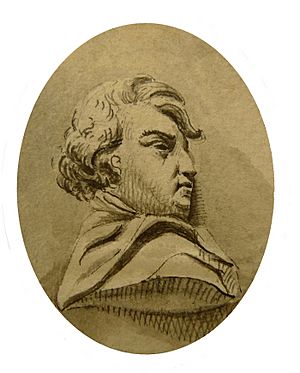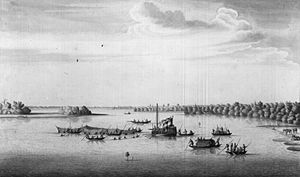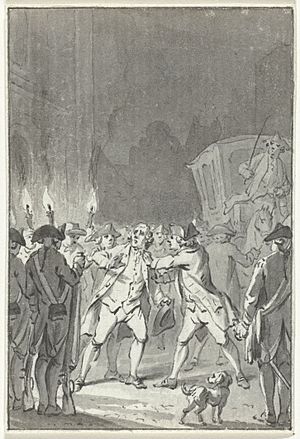Joan Gideon Loten facts for kids
Joan Gideon Loten (born May 16, 1710 – died February 25, 1789) was an important Dutch official. He worked for the Dutch East India Company (VOC), a powerful trading company. Loten became the 29th Governor of Zeylan (which is now Sri Lanka). He was also a member of famous groups like the Royal Society and the Society of Antiquaries of London. During his time in the colonies, he collected many interesting plants and animals. The sunbird species Cinnyris lotenius is named after him.
Contents
A Life of Adventure and Learning
Growing Up and Early Studies
Joan Gideon Loten was born on May 16, 1710, in a place called Schadeshoeve, near Utrecht, in the Netherlands. His father, Joan Carel Loten, was a secretary. Joan was raised in the Dutch Reformed Church.
When he was young, Loten went to the Utrecht Hieronymus School. He studied Latin and Greek there. In 1726, he became a student at Utrecht University. One of his teachers, Pieter van Musschenbroek, sparked Loten's interest in space and math.
In 1728, Loten left university. He started working as a clerk for the Amsterdam Chamber of the Dutch East India Company. In 1731, he was promoted to junior merchant.
Working in the Dutch East Indies
In January 1732, Loten sailed from the Netherlands to Batavia (which is now Jakarta, Indonesia). He became a prosecutor there. During his long sea journey, he kept notes about nature.
On August 24, 1733, he married Anna Henrietta van Beaumont. Her family was well-known in Batavia. Loten later became an administrator in Semarang. He managed to stay safe during a conflict between the Dutch and Chinese people from 1740 to 1743.
In 1743, he was chosen to be the Governor of Makassar (now Ujung Pandang). He held this position from 1744 to 1750. He worked to manage trade and relations with local leaders.
In 1749, Loten became a Councillor of the Dutch East Indies. He helped set up a friendly ruler in Bantam in 1752.
In February 1752, the Governor of Ceylon died. In June 1752, Loten was appointed the new Governor of Ceylon. He traveled to Colombo with his wife and daughter.
Loten was seen as a good leader in Ceylon. He faced challenges like a plague and a big storm. He tried to protect the cinnamon forests from being turned into farmland. He was generally respectful of the local people.
Sadly, on July 30, 1755, Loten's two-year-old grandson died. Then, on August 10, 1755, his wife, Anna Henrietta, also passed away. She was buried in Colombo.
In March 1756, Loten asked to leave his job in Ceylon. He wanted to move to Batavia to be with his daughter. He sailed to Batavia in March 1757. A talented artist, Pieter Cornelis de Bevere, was on board. He drew many birds for Loten.
On May 15, 1757, Loten's daughter, Arnoldina Deliana, died. This was a very difficult time for him. He decided to leave for Holland on October 29, 1757. On his way, he stopped at the Cape of Good Hope and met Governor Rijk Tulbagh. Loten suffered from asthma during his journey and for the rest of his life.
Life Back in Europe
Loten arrived back in the Netherlands on June 15, 1758. He returned with a large fortune. This money came from his work and some private trading. He also inherited money from a former governor. This wealth gave him financial freedom.
However, Loten felt like an outsider in the Netherlands. He decided to move to London, England, in May 1759. He lived there for 22 years, with some breaks. He enjoyed London's lively and intellectual atmosphere.
In November 1760, he was elected a Fellow of the Royal Society. This is a very respected group for scientists. He also became a Fellow of the Society of Antiquarians.
Loten continued to have health issues, especially asthma. In 1765, he married Laetitia Cotes. They lived in Utrecht for a while, then returned to England.
He worked with famous naturalists like Joseph Banks and Thomas Pennant. They helped share his natural history collections and drawings.
In 1780, the Fourth Anglo-Dutch War started. In November 1781, Loten returned to Utrecht for good. He died in his house in Utrecht on February 25, 1789. He was buried in the Jacobi church.
A monument was built in his memory in Westminster Abbey in London in 1795.
Loten's Love for Nature
Loten was very knowledgeable about animals, space, family history, and medicine of his time. He loved collecting natural items, especially rare and unique ones. He was fascinated by the natural world.
He gave many of his collections to the British Museum in London. He donated beautiful watercolor paintings, stuffed birds, and minerals. Joseph Banks, a famous naturalist who traveled with Captain James Cook, was Loten's neighbor.
Thanks to Banks and other naturalists like Thomas Pennant and George Edwards, Loten's natural history collection was copied and described in many books. Unfortunately, some of the bird specimens he gave were later damaged because of old preservation methods.
Today, parts of Loten's collection can be found in several museums. These include the Natural History Museum, London, the British Library, and the Teylers Museum in Haarlem. Documents about his time in the colonies are kept in the national archive in The Hague.
Images for kids












